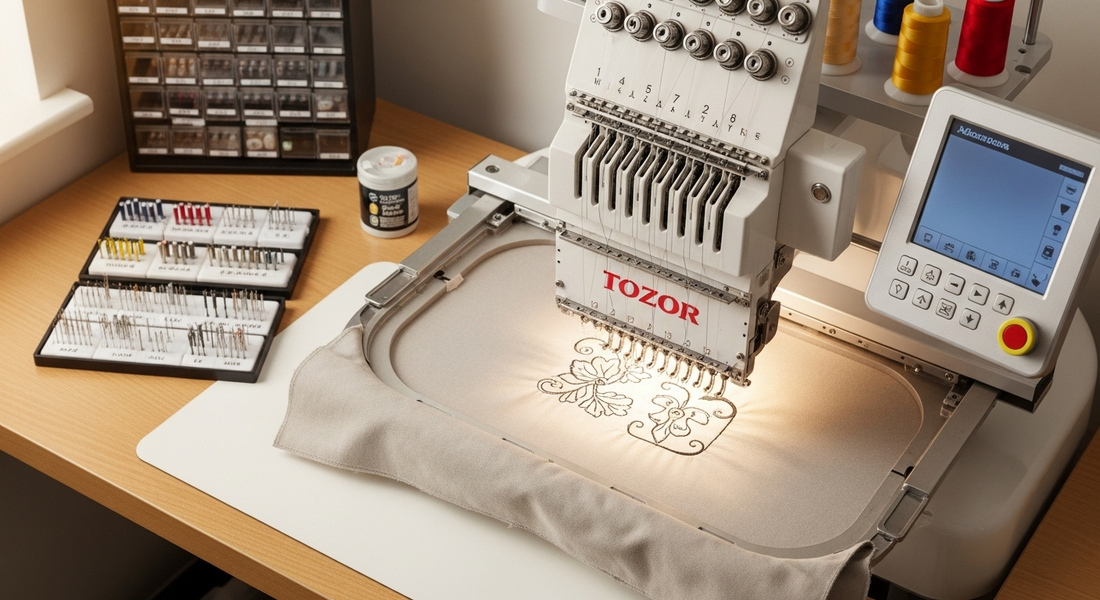
Getting Thread Tension and Needle Choice Right in Machine Embroidery
Share
If you’ve ever had a design turn out less than perfect—even though your file looked great and your fabric seemed right—the problem might’ve been hiding in plain sight: thread tension or needle choice. These two small details can make or break your project, no matter how advanced your machine is.
Let’s break things down with some real-world tips, minus the techy jargon.

1. What’s the Deal with Thread Tension?
Think of thread tension as a gentle tug-of-war between your top thread and bobbin thread. When the tension’s just right, your stitches lie flat and smooth—no bunching, no gaps.
Here’s what to watch out for:
- Too tight? Your fabric might start to pucker, and you’ll probably see some bobbin thread sneak up to the front.
- Too loose? You’ll notice loops on the fabric surface or uneven lines on the back.
The goal? Balance. You want the top thread and bobbin thread to meet in the middle—literally.
2. How to Tweak Tension Without Guessing
Most machines let you adjust the top thread tension either with a knob or digitally. As for the bobbin, leave it alone unless you’re using a special thread or bobbin case.
A few tips that save headaches:
- Always test on a scrap piece first. Always.
- Make tiny changes—don’t crank it way up or down all at once.
- Using thicker or metallic threads? Ease off on the tension.
- Embroidery looking tight or rigid? Try loosening it just a touch.
Quick rule of thumb: On the back of your fabric, you should see a mix of about 2/3 top thread and 1/3 bobbin thread. That’s your happy zone.

3. Why the Right Needle Really Matters
Choosing the wrong needle is like painting with a frayed brush. You might still get color on the canvas, but it won’t be pretty.
Your choice depends on:
- What kind of fabric you’re using (knit, woven, thick, sheer?)
- The thickness of your thread
- How dense or detailed your design is
Some go-to needle types:
- Embroidery Needles: For most projects—versatile and gentle on thread
- Ballpoint Needles: Great for stretchy knits (they glide through instead of piercing)
- Sharp Needles: Perfect for tough woven fabrics or dense patterns
- Metallic Needles: Designed for finicky, break-prone metallic threads
4. A Handy Needle Size Guide
|
Needle Size |
Best For |
|
70/10 |
Delicate fabrics, fine threads |
|
75/11 |
Everyday embroidery on cotton or linen |
|
80/12 |
Midweight fabrics and denser stitching |
|
90/14 |
Thick fabrics or metallic threads |
|
100/16 |
Canvas, denim, or multi-layered projects |
Reminder: Needles wear out. Even if it looks fine, a slightly dull needle can mess up your stitching. If in doubt—swap it out.

5. Common Embroidery Mishaps—and How to Fix Them
|
What Went Wrong |
Likely Cause |
Quick Fix |
|
Thread fraying |
Dull or wrong-sized needle |
Try a new needle or size up |
|
Puckered fabric |
Tension too high |
Loosen the upper thread |
|
Loops on fabric |
Tension too loose or needle too thick |
Tighten tension or downsize the needle |
|
Skipped stitches |
Needle doesn’t suit the job |
Match needle type to your fabric and thread |
6. Stitching Smarter, Not Harder
- Always do a quick test before working on your actual project.
- Invest in good-quality needles and thread—you’ll notice the difference.
- Keep a simple chart of what worked best for which fabric or project. Future-you will thank you.
- Replace needles regularly. Don’t wait for trouble to start showing up in your stitches.

In Closing…
Embroidery is an art, yes—but it’s also a craft that depends on the smallest details. Once you get comfortable adjusting your tension and selecting the right needle, everything else becomes smoother. Clean stitches, fewer breakages, and better-looking work—it’s all within reach with just a bit of practice and observation.